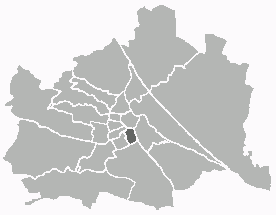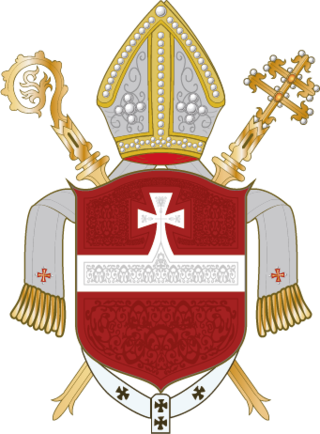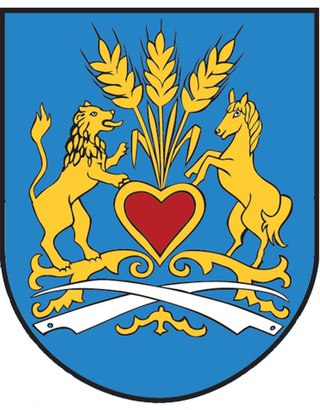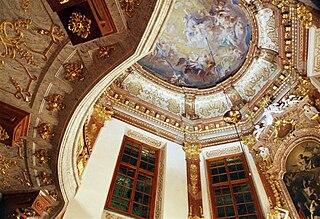
St. Stephen's Cathedral is the mother church of the Roman Catholic Archdiocese of Vienna and the seat of the Archbishop of Vienna, Christoph Cardinal Schönborn, OP. The current Romanesque and Gothic form of the cathedral, seen today in the Stephansplatz, was largely initiated by Duke Rudolf IV (1339–1365) and stands on the ruins of two earlier churches, the first a parish church consecrated in 1147. The most important religious building in Vienna, St. Stephen's Cathedral has borne witness to many important events in Habsburg and Austrian history and has, with its multi-coloured tile roof, become one of the city's most recognizable symbols. It has 256 stairs from the top to the bottom

Landstraße is the 3rd municipal district of Vienna, Austria. It is near the center of Vienna and was established in the 19th century. Landstraße is a heavily populated urban area with many workers and residential homes. It has 89,834 inhabitants in an area of 7.42 km2. It has existed since about 1200 AD. In 1192, the English king Richard the Lionheart was captured in the Erdberg neighbourhood, after the unsuccessful Third Crusade.

The Innere Stadt is the 1st municipal district of Vienna located in the center of the Austrian capital. The Innere Stadt is the old town of Vienna. Until the city boundaries were expanded in 1850, the Innere Stadt was congruent with the city of Vienna. Traditionally it was divided into four quarters, which were designated after important town gates: Stubenviertel (northeast), Kärntner Viertel (southeast), Widmerviertel (southwest), Schottenviertel (northwest).

Josefstadt is the eighth district of Vienna. It is near the center of Vienna and was established as a district in 1850, but borders changed later. Josefstadt is a heavily populated urban area with many workers and residential homes. It has a population of 24,279 people (2014). With an area of 1.08 km2, Josefstadt is the smallest district in Vienna, and was named after the Holy Roman Emperor Joseph I.

The Kahlenberg is a mountain located in the 19th District of Vienna, Austria (Döbling).

Wieden is the 4th municipal district of Vienna, Austria. It is near the centre of Vienna and was established as a district in 1850, but its borders were changed later. Wieden is a small region near the city centre. After World War II, Wieden was part of the Soviet sector of Vienna for 10 years.

St. Marx Cemetery is a cemetery in the Landstraße district of Vienna, used from 1784 until 1874. It contains the unmarked grave of the famous composer Wolfgang Amadeus Mozart.

Palais Augarten is a Baroque palace in the district of Leopoldstadt, Vienna, Austria. Constructed in the late seventeenth century by Johann Bernhard Fischer von Erlach on the site of a Jagdschloss and gardens, the palace and gardens were expanded in the nineteenth century under Emperor Franz Joseph I of Austria. Despite extensive damage suffered during World War II, the palace has been maintained almost in its original appearance, and many of the original furnishings can still be found there. Today, Palais Augarten is the home and rehearsal space of the Vienna Boys' Choir, who also have their own school there. The palace is located in the 130-acre Augarten park, which is the oldest Baroque garden in Vienna.

The Leopoldsberg is perhaps Vienna’s most famous hill, towering over the Danube and the city. Leopoldberg’s most prominent landmark is the church which stands at the top, and which is clearly visible from Vienna below. Construction of the Leopoldsberg church, dedicated to Saint Leopold, began in 1679; an expansion following a design by Antonio Beduzzi was undertaken 1718–30. Other renovations were to follow. Across the square from the church, on what used to be a tower of the fortification system, a memorial to those Austrians who returned home from captivity after World War II was created in 1948.

Mumok is a museum in the Museumsquartier in Vienna, Austria.

The Archdiocese of Vienna is a Latin Church archdiocese of the Catholic Church in Austria. It was erected as the Diocese of Vienna on 18 January 1469 out of the Diocese of Passau, and elevated to an archdiocese on 1 June 1722. The episcopal see is situated in the cathedral of S. Stephen in Vienna.

The Servite Church is a church in Vienna, Austria.

Kalksburg is a former municipality in Lower Austria that is now a part of the 23rd Viennese district Liesing.

Inzersdorf was before 1938 an independent municipality, and is now a part of the 23rd Viennese district Liesing.

Belvedere Palace Chapel is a chapel located in the south eastern corner tower of the Upper Belvedere in Vienna, Austria. It was designed by the Austrian architect Johann Lukas von Hildebrandt.

Am Schöpfwerk Church is a Roman Catholic parish church, dedicated to Saint Francis of Assisi, and is the most recently built church in Meidling, the 12th district of Vienna, Austria.

Café Griensteidl was a traditional Viennese café located at Michaelerplatz 2 across from St. Michael's Church and St. Michael's Gate at the Hofburg Palace in the Innere Stadt first district of Vienna, Austria. The café was founded in 1847 by former pharmacist Heinrich Griensteidl. In January 1897, the original building was demolished during the course of the renovation of Michaelerplatz. During the early twentieth century, the café was frequented by many artists, musicians, and writers, including Hugo von Hofmannsthal, Arthur Schnitzler, Arnold Schoenberg, Alexander Zemlinsky, Hermann Bahr, Friedrich Eckstein, Rudolf Steiner, Hugo Wolf, and Stefan Zweig.

The Max Perutz Labs Vienna are a molecular biology research centre operated jointly by the University of Vienna and the Medical University of Vienna located at the Vienna Biocenter. The institute is named after the Viennese-born biochemist and Nobel laureate Max Ferdinand Perutz. On average, the institute hosts 50 independent research groups. Max Perutz Labs scientists participate in the undergraduate curricula for students of the University of Vienna and the Medical University of Vienna.

Jedlesee is a suburb of Floridsdorf, the 21st district of Vienna. An independent community until 1894, it was joined along with Leopoldau, Donaufeld, Floridsdorf and Neu Jedlesdorf to the greater Floridsdorf municipality, becoming part of Vienna in 1904. Jedlesee is most notable for being the site of the estate of Countess Anna Maria Erdődy, close friend and patron of Beethoven, who stayed there with her on numerous occasions between 1805 and 1818.

The Alte Rathaus is a building in central Vienna, located at Wipplingerstraße 8, 1st District.




















